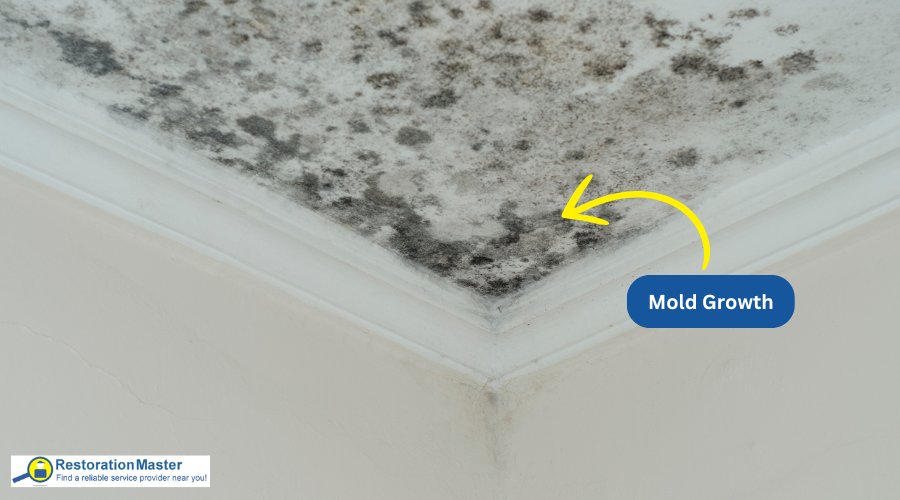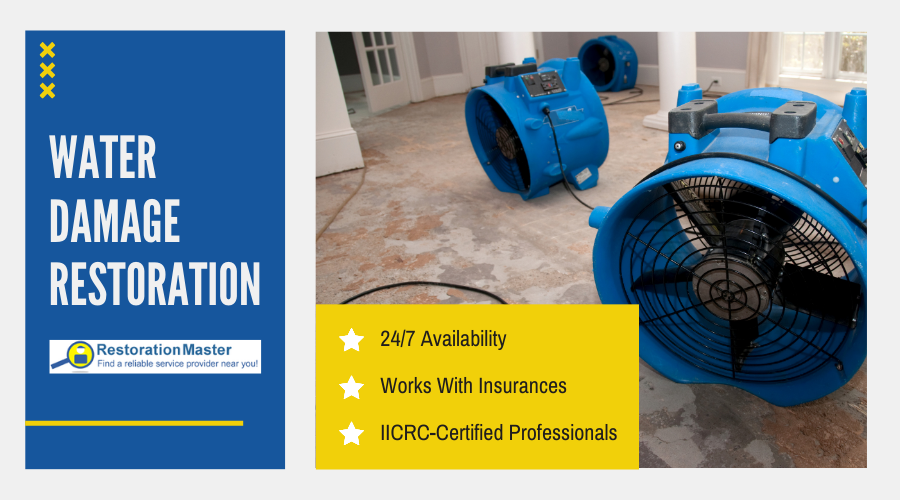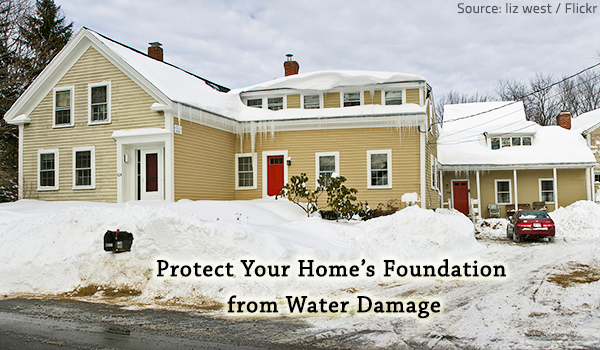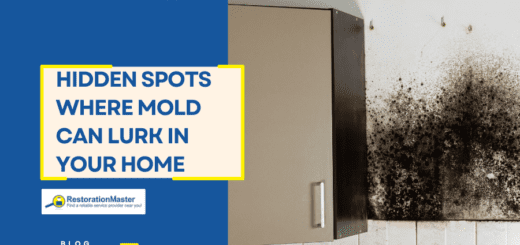How to Determine if Water Damage is Fresh or Old | Video
Discovering signs of water damage can be a nightmare for homeowners. What’s visible might only be the tip of the iceberg, concealing a far more extensive issue beneath the surface. Fortunately, newer water damage is often easier to address compared to older water damage that has likely resulted in more severe damage to the affected materials. This guide will help you determine whether the water damage you find is fresh or old.
Key Takeaways:
- Identifying Water Damage: Water damage can be fresh or old, with newer damage being easier to address before it worsens.
- Signs of Water Damage Age: Look for water rings, discoloration, texture changes, moldMold is a type of fungus that grows in damp or humid conditi... More growth, warpingWarping is the bending, twisting, or distortion of materials... More, musty odors, and rustRust is a reddish-brown oxide that forms on iron or steel du... More to estimate how long water has been present.
- Common Causes: Plumbing issues, roof leaks, HVAC problems, clogged gutters, natural disasters, and human errors can all leadLead is a heavy metal that can be toxic to humans, especiall... More to water damage.
- Immediate Action is Crucial: Water spreads quickly through porousPorous describes a material that contains small openings or ... More materials like drywall and wood, potentially leading to structural damage and moldMold is a type of fungus that grows in damp or humid conditi... More growth.
- Professional RestorationRestoration is the process of returning a property to its pr... More Helps: Experts use advanced techniques to extract water, dry affected areas, and restore properties to prevent long-term damage.
Is This Water Damage New or Old?
To catch issues that can leadLead is a heavy metal that can be toxic to humans, especiall... More to water damage early, homeowners should regularly inspect vulnerable areas of their homes. Understanding how different materials respond to moisture is also crucial, as not all materials react the same way to water exposure. For instance, hard materials like brick, tile, or stone often take months to show signs of damage because water takes longer to penetrate these materials. On the other hand, porousPorous describes a material that contains small openings or ... More materials such as drywall and carpeting reveal water damage almost immediately because of how quickly they absorb water.
It’s important to note that determining exactly how long water damage has been present—whether days, weeks, or months—is nearly impossible. However, getting an idea of whether the damage is recent or occurred a while ago can help determine the next steps in addressing the issue. The following tips will help you tell how long ago the water damage occurred.
Count the Water Rings
Homeowners can often estimate the age of water spots on ceilings or walls by looking for rings around the water spot. A freshwater spot typically appears as a single, solid, dark stain without any surrounding rings.
In contrast, older water spots are usually bordered by one or more rings. The more rings present, the older the issue is likely to be as the number of rings indicates how many times the area has been soaked and dried as the water spread.
Check the Discoloration of the Stains
If you find water stains, take note of the color of the stains. Fresh water stains appear as wet patches or streaks and they are dark in color because they have not had time to dry out yet. Old water stains are light yellow or brown in color from dryingDrying is the process of removing moisture from materials, s... More out.
Touch the Damaged Surface
Another way to determine the age of the water damage is to touch the damaged surface. PorousPorous describes a material that contains small openings or ... More materials like wood and drywall absorb water, so the feel of these materials can provide a clue as to how long ago the damage occurred.
If materials like wood and drywall are wet but structurally firm, the water damage is still fresh because the water hasn’t had enough time to become thoroughly absorbed. If the affected materials are soft, spongy, or mushy, this is a sign that these materials have absorbed a significant amount of water over time. However, the opposite is true with soft materials like insulationInsulation is a material used in buildings to reduce the tra... More and drywall, as these materials will feel wet and mushy to the touch right away because of how quickly they absorb water. It is best to use gloves when touching water-damaged areas to protect yourself from moldMold is a type of fungus that grows in damp or humid conditi... More exposure.
Look for Mold Colonies
MoldMold is a type of fungus that grows in damp or humid conditi... More sporesSpores are microscopic reproductive units of fungi or mold t... More reproduce quickly when they find the right conditions, specifically areas rich in moisture and organic matter. If you notice moldMold is a type of fungus that grows in damp or humid conditi... More spots on water-damaged walls or ceilings, it’s a sign the damage has been present for several days. MoldMold is a type of fungus that grows in damp or humid conditi... More can begin to grow within just 24 to 48 hours after water exposure.
Visible black or gray moldMold is a type of fungus that grows in damp or humid conditi... More spots are often just the tip of the iceberg. MoldMold is a type of fungus that grows in damp or humid conditi... More infestations can also hide behind walls or beneath carpets, suggesting that the water damage has been ongoing for some time. This concealed growth can pose a significant challenge, as it may remain undetected until it has spread extensively.
MoldMold is a type of fungus that grows in damp or humid conditi... More is more than an inconvenience; it’s a health hazard. Handling it without proper precautions can scatter airborne sporesSpores are microscopic reproductive units of fungi or mold t... More, spreading the contaminationContamination is the presence of harmful or unwanted substan... More to other parts of your home. If you must address moldMold is a type of fungus that grows in damp or humid conditi... More yourself, always wear a mask to avoid inhaling sporesSpores are microscopic reproductive units of fungi or mold t... More and gloves to prevent cross-contaminationCross-contamination occurs when harmful substances, such as ... More. For extensive growth, it’s best to call in professionals to ensure safe and effective mold removal.

Check for Swelling, Warping, and Buckling
PorousPorous describes a material that contains small openings or ... More materials like wood and drywall may warp or swell when affected by water damage. However, the appearance of the warpingWarping is the bending, twisting, or distortion of materials... More and swelling can help you tell how long ago the water damage occurred.
If the water damage is recent, walls and ceilings may show water bubbles. There may be noticeable bends or curves in wooden flooring, furniture, and wooden structural elements may swell beyond their normal size. If the water damage is older, the walls and ceilings may be mushy and deteriorated, while wooden flooring may be severely warped and buckled. In many cases, the warpingWarping is the bending, twisting, or distortion of materials... More and buckling may be severe enough to require the wooden floor to be replaced.
Check for Structural Decay
The deterioration of the home’s walls, ceilings, tiles, and other structural materials happens over an extensive period. When a home’s interior structures break down due to the presence of moisture, it usually means water damage has occurred multiple times.
The decay of structural materials happens under extreme conditions. Rainstorms, sewageSewage is wastewater containing biological and chemical cont... More backups, or other causes of floodingFlooding is the overflow or accumulation of water in areas t... More introduce standing water into the home. When consistent and prolonged, the standing water will result in severe decay of structural elements like walls, flooring, ceilings, and wooden supports.
Water damage of any duration should be dealt with swiftly. Water damage spreads rapidly and can affect other parts of the home, resulting in time-consuming and costly repairs. Homeowners are advised to routinely inspect their homes to prevent or respond to water damage.
Be Aware of Musty Odors
Fresh and old water damage may result in musty odors, but the odors are slightly different depending on how long ago the water damage occurred. Recent water damage emits an odorAn odor is a smell, often detectable by the human nose, whic... More that is similar to the smell of wet cardboard or paper. If the odorAn odor is a smell, often detectable by the human nose, whic... More is more of a strong, musty odorAn odor is a smell, often detectable by the human nose, whic... More, then the water damage is older and there may also be moldMold is a type of fungus that grows in damp or humid conditi... More growth that is contributing to the odorAn odor is a smell, often detectable by the human nose, whic... More.
Look for Rust or Corrosion
To assess the age of water damage, examining rustRust is a reddish-brown oxide that forms on iron or steel du... More or corrosion on metal fixtures and pipes can provide valuable clues. With fresh water damage, metal surfaces appear relatively clean but may show the initial signs of rustRust is a reddish-brown oxide that forms on iron or steel du... More, indicating the presence of moisture. Over time, prolonged exposure to water leads to more advanced rustRust is a reddish-brown oxide that forms on iron or steel du... More and corrosion, which are clear indicators of older water damage.
What are the Main Causes of Water Damage?
Understanding the main causes of water damage within your home can help you better check for signs of water damage and take action right away to prevent significant damage. The following are the main causes of water damage within homes:
- Plumbing problems: Issues with the plumbing system, such as leaking or broken pipes, damaged or leaking fixtures, and faulty appliances like washing machines, dishwashers, and water heaters, can cause significant water damage.
- Natural disasters: Heavy rain, floodingFlooding is the overflow or accumulation of water in areas t... More, and severe storms like hurricanes can leadLead is a heavy metal that can be toxic to humans, especiall... More to floodingFlooding is the overflow or accumulation of water in areas t... More within your home. Floodwater also typically contains pollutants and contaminants that can put your health at risk.
- Roof leaks: Leaks from the roof can cause significant damage as the water gets absorbed into the surrounding building materials. Roof leaks may occur due to damaged or missing shingles as well as damaged flashing and seals.
- Issues with the HVAC system: The condensation line within air conditioners and heaters may become clogged or damaged when these units are not functioning properly, which can cause leaks.
- Appliance malfunction: Appliances like refrigerators and freezers have water lines that may leak if they become clogged or damaged.
- Clogged gutters: If the gutters are clogged, they will not be able to effectively drain rainwater. The water in the gutters will eventually overflow and run down the side of the house, resulting in water damage to the ceilings, walls, and flooring, as well as pooling near the foundation of the home.
- Human error: Sometimes, water damage is caused by human error, such as leaving a faucet running.
Does Water Damage Require Immediate Repair?
Yes, water damage requires immediate repairRepair is the act of fixing or restoring damaged property, m... More, no matter how recently the water damage has occurred. Water will continue spreading through porousPorous describes a material that contains small openings or ... More building materials in your home, such as wood and drywall, which can increase the amount of total damage and leadLead is a heavy metal that can be toxic to humans, especiall... More to additional problems like moldMold is a type of fungus that grows in damp or humid conditi... More and structural damage. It is crucial for the water to be contained and removed to limit the damage and restore the affected areas.
If areas with old water damage appear dry, that does not mean they should be ignored. There may be significant underlying damage such as structural damage and hidden moldMold is a type of fungus that grows in damp or humid conditi... More, that must be addressed immediately.
Does Water Damage Show Immediately?
This varies depending on the situation and the materials affected. PorousPorous describes a material that contains small openings or ... More materials such as drywall, carpeting, insulationInsulation is a material used in buildings to reduce the tra... More, wallpaper, and wood may show signs of water damage immediately because of how quickly they absorb water. However, materials like brick, tile, and stone may not show signs of water damage for months because of how slowly water penetrates these materials.
When to Call Professionals for Water Damage Restoration

Determining whether water damage is fresh or old is crucial for addressing the issue effectively and preventing further damage to your home. By paying attention to key indicators such as water rings, discoloration, texture, moldMold is a type of fungus that grows in damp or humid conditi... More growth, and structural changes, homeowners can get a better idea of how long the damage has been present. Regardless of the age of the damage, immediate action is essential to prevent costly repairs and potential health risks. Regular home inspections, prompt repairs, and professional assistance when needed can help protect your home from the long-term effects of water damage.
When faced with water damage, swift action is essential to minimize its impact. Contact trusted water damage restoration professionals for prompt and expert assistance, they’ll work to restore your home or business to its pre-damage condition.
Water quickly seeps into porousPorous describes a material that contains small openings or ... More materials like drywall, insulationInsulation is a material used in buildings to reduce the tra... More, and upholstery, often leading to significant structural damage if not addressed promptly. RestorationRestoration is the process of returning a property to its pr... More teams act fast to extract moisture and thoroughly dry the affected areas, preventing further harm. Using state-of-the-art equipment, water damage technicians efficiently remove water from furniture, walls, and structural components. Additionally, they are trained to handle hazardous situations, including the safe removal of sewageSewage is wastewater containing biological and chemical cont... More water, which can carry harmful bacteria and virusesViruses are microscopic infectious agents that can only repr... More.












